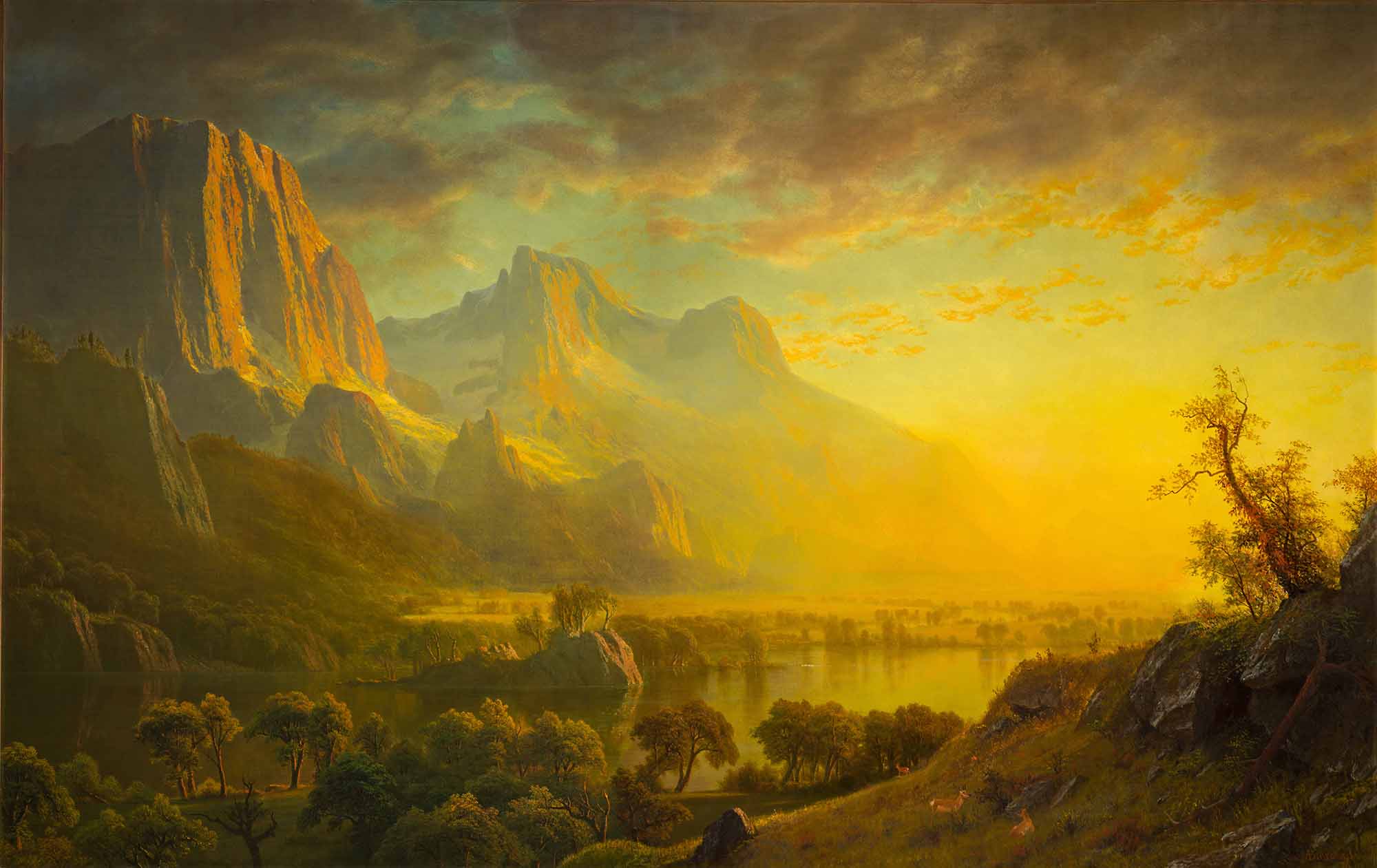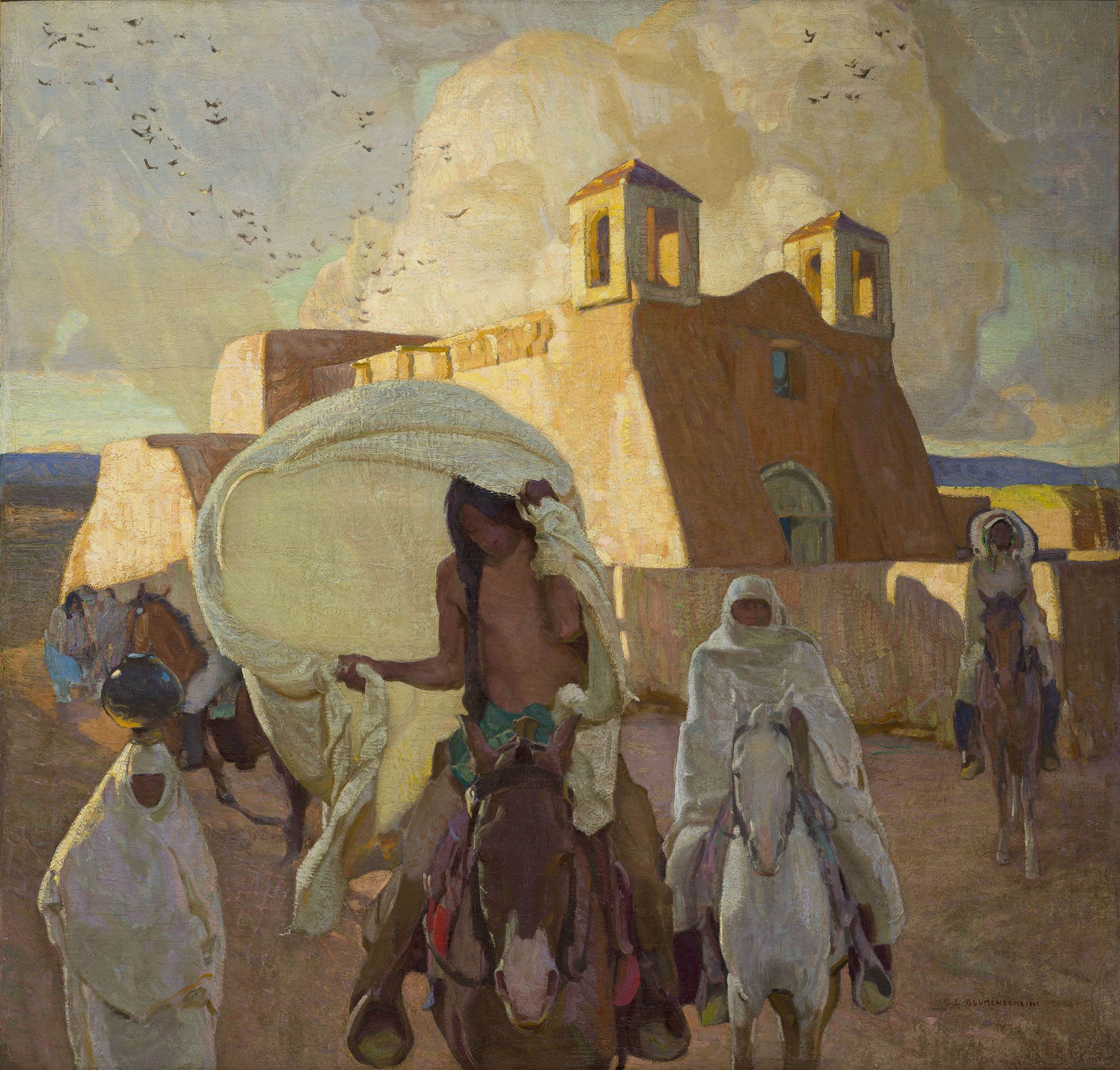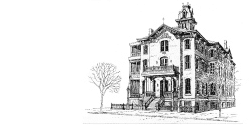Western American Art in Style
Background Information
Westward expansion led to multiple developments socially, politically, and culturally as it moved across the United States. American artists were often a part of the forefront of these changes, documenting and adapting their artwork throughout. They were interested in creating artwork unique to America, separate from the work coming out of Europe. Over time, different styles erupted across the United States as artists moved west and changes in American life took hold.
Look Closer
Hudson River School vs. Regionalism
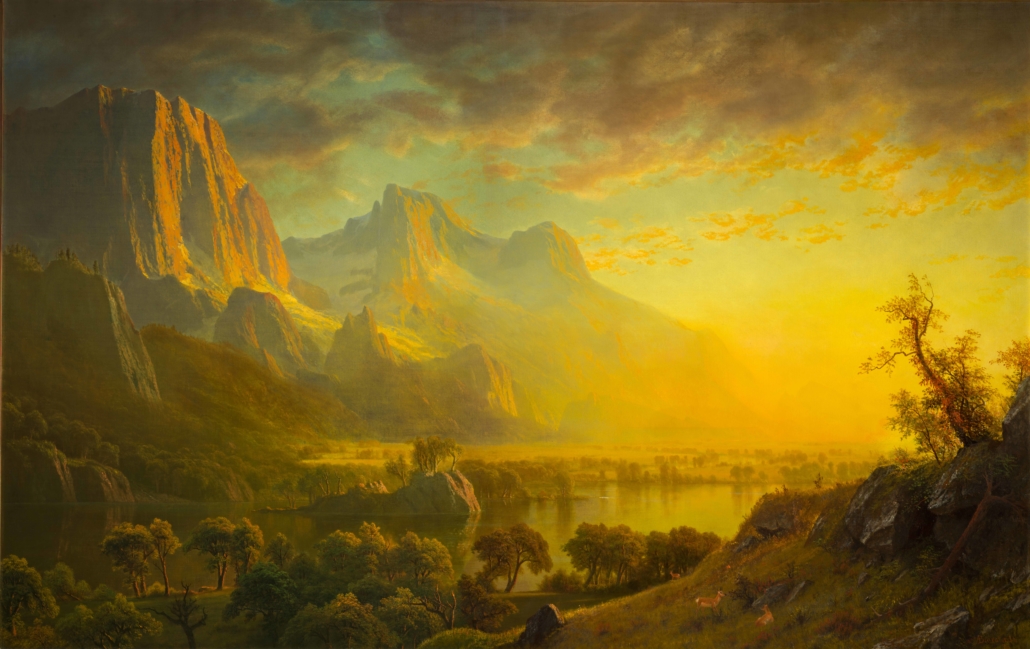
This painting, like many other Hudson River School works, is a landscape produced on a large canvas.
Notice the dramatic skies and intense sunlight that hits different parts of the land.
Look for the small deer in the foreground of the painting, Hudson River School artists would include small animals or people to show the immensity of the landscape.
Albert Bierstadt, Wind River, Wyoming, 1870.
The artist of this painting, Albert Bierstadt, was one of the most recognized Hudson River School artists. This painting, like many other Hudson River School works, is a landscape produced on a large canvas1. Notice the dramatic skies and intense sunlight that hits different parts of the land2. Look for the small deer in the foreground of the painting, Hudson River School artists would include small animals or people to show the immensity of the landscape3.

We see farmers in the Midwest using tractors and other farm equipment to thresh wheat, a typical every day scene seen in Regionalist work.
Look at the color and lines used to create the shapes in the image, notice how they do not appear real.
Thomas Hart Benton, Wheat Threshing on the High Plains, 1969.
Thomas Hart Benton was a notable American Regionalist who, like many other Regionalists, wanted to document and preserve the hardworking people of the American Midwest. In this painting we see farmers in the Midwest using tractors and other farm equipment to thresh wheat, a typical every day scene seen in Regionalist work1. Look at the color and lines used to create the shapes in the image, notice how they do not appear real2. Regionalist artists wanted to document the Midwest but with their own artistic style, rejecting realism but also rejecting pure abstraction.
Taos Society vs. Abstract Expressionism

Look for the way the light hits the different parts of the building and land in this scene.
Taos artists typically blended recent European art styles with a more traditional American style, see if you can spot visible brushstrokes on the canvas.
Taos Society artists focused solely on New Mexico scenes, in this painting you can see the San Francisco de Asis Church that still stands to this day in Taos.
Ernest Leonard Blumenschein, Church at Ranchos de Taos, 1916.
The Taos Society of Artists was an artist community in Taos, New Mexico from 1915 to 1927. Ernest Blumenschein, like the other Taos artists, was inspired by the light, land, and peaceful environment of Taos. Look for the way the light hits the different parts of the building and land in this scene1. Taos artists typically blended recent European art styles with a more traditional American style, see if you can spot visible brushstrokes on the canvas2. Taos Society artists focused solely on New Mexico scenes, in this painting you can see the San Francisco de Asis Church that still stands to this day in Taos3.
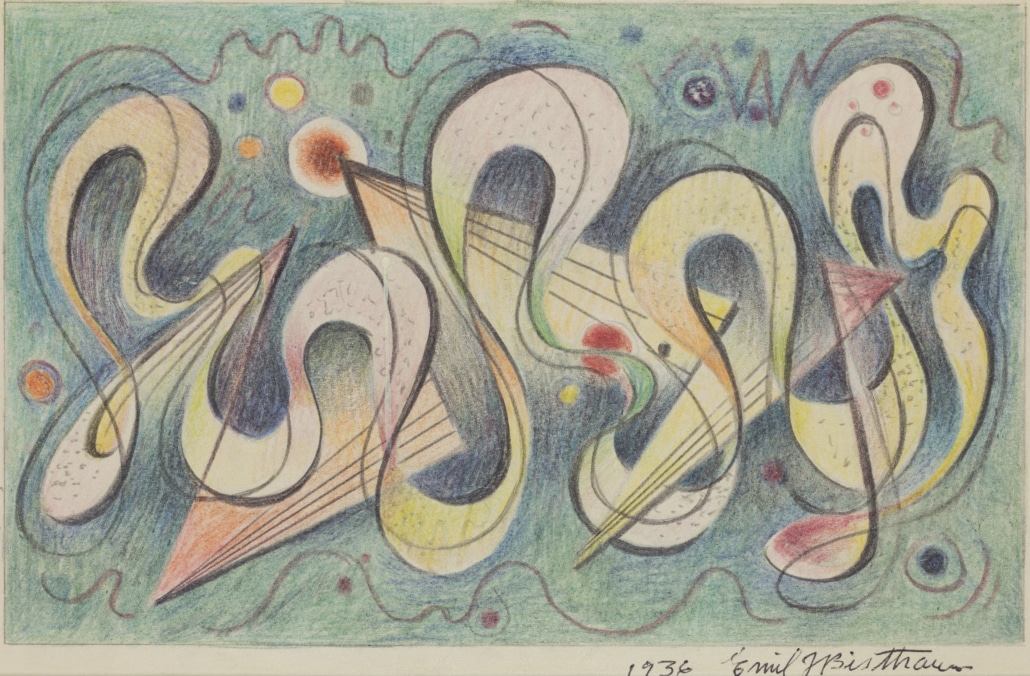
Look at the above painting by Bisttram and think about what the subject might be. Abstract Expressionist artists aimed to create work that focused on personal emotion and experience rather than a visual subject.
This piece is called Rhythms—The Waltz, some Abstract artists would create artwork based on the way music sounded and the emotions it evoked. See if you can spot the movement of Bisttram’s hand creating this work to music.
Emil Bisttram, Rhythms—The Waltz, 1936.
Abstract Expressionism began in the early 1940’s and was a way for artists to break away from traditional subject matter. Emil Bisttram was an artist who experimented with many different styles throughout his career, including Abstract Expressionism. Look at the above painting by Bisttram and think about what the subject might be. Abstract Expressionist artists aimed to create work that focused on personal emotion and experience rather than a visual subject1. This piece is called Rhythms—The Waltz, some Abstract artists would create artwork based on the way music sounded and the emotions it evoked. See if you can spot the movement of Bisttram’s hand creating this work to music2.
Documentary vs. Modernism

These Documentary artists were interested in creating sketches and artwork that recorded the new lands, plants, animals, and people they were seeing for the first time. The painting above depicts a scene inside the lodge of the Mandan tribe in modern-day North Dakota.
These artworks were shown to people back east as accurate representations of the lands, people, and animals of the West.
George Catlin, Interior of Mandan Lodge, c. 1832.
George Catlin, like many artists throughout the 1800s, accompanied different western expeditions to create accurate visual records of the West. These Documentary artists were interested in creating sketches and artwork that recorded the new lands, plants, animals, and people they were seeing for the first time. The painting above depicts a scene inside the lodge of the Mandan tribe in modern-day North Dakota1. Documentary Artists would create sketches to bring back with them to their studio to complete the artwork or, as Catlin did for this painting, complete the work onsite. These artworks were shown to people back east as accurate representations of the lands, people, and animals of the West2.

American Modernists began to reject realism and traditional styles of art. Look at the painting above by Victor Higgins and notice that the people in the painting are recognizable but not realistic looking.
Observe how Higgins, like other American Modernists, experiments with line, color, and form.
Artists also became interested in putting emphasis on the materials
Victor Higgins, Pueblo of Taos, before 1927.
American Modernists began to reject realism and traditional styles of art. Look at the painting above by Victor Higgins and notice that the people in the painting are recognizable but not realistic looking1. Observe how Higgins, like other American Modernists, experiments with line, color, and form2. Artists also became interested in putting emphasis on the materials3 and techniques used to create the work.
Discussion Questions
- How would you describe the difference between Hudson River School and Regionalism styles?
- How would you describe the difference between Regionalism and Abstract Expressionism?
- How would you describe the difference between Documentary and Modernism?
- Why do you think America would want to keep up with the art coming out of Europe?
- Can you tell which time period this artist was working in and how?
- How does the style used add to the scene at hand?
- Do you feel an emotional response to this Abstract Expressionist piece?
- What feelings do you think the artist was attempting to convey?
- What tools do you think were used to create this piece?
Activity
Discuss multiple styles/movements that were popular during different moments in America. Compare and contrast similar or different styles, using Visual Thinking Strategies to allow the students to make their own assumptions. Explain what is happening in each piece and its historical context in relation to why it was painted in a particular style.
Set up a still life, head outside to create a landscape, create a self-portrait or portrait of a classmate, or an image based off of a photograph. Imagine yourself seeing this site for the first time and attempt to capture those emotions/ideas in your recreation to the image/scene. Choose two different styles discussed that resonated with you and split the surface you will create on, down the middle. On each side of the surface create the image in different styles.
Materials:
Pencils/Colored Pencils
Charcoal
Oil Pastels
Acrylic Paint
Watercolor Paint
Oil Paint
Paper
Watercolor Paper
Canvas/Canvas Board
Grade levels: P-12 CO Standards
Reading, Writing and Communicating (2020)
Preschool: 1.1-2 ; 4.1
Kindergarten: 1.1-2 ; 4.1
1st Grade: 1.1-2 ; 4.1
2nd Grade: 1.1-2 ; 4.1
3rd Grade: 1.1-2
4th Grade: 1.1-2
5th Grade: 1.1-2
6th Grade: 1.1-2
7th Grade: 1.1
8th Grade: 1.1
9th/10th Grade: 1.1
11th/12th Grade: 1.1-2
Visual Arts (2020)
Preschool: 1.1 ; 2.1 ; 3.1 ; 4.1
Kindergarten: 1.1 ; 2.1 ; 3.1 ; 4.1
1st Grade: 1.1 ; 2.1 ; 3.1 ; 4.1
2nd Grade: 1.1 ; 2.1 ; 3.1 ; 4.1
3rd Grade: 1.1 ; 2.1 ; 3.1 ; 4.1
4th Grade: 1.1-2 ; 2.1-2 ; 3.1-2 ; 4.1
5th Grade: 1.1-2 ; 2.1-2 ; 3.1-2 ; 4.1
6th Grade: 1.1-3 ; 2.1-2 ; 3.1-3 ; 4.1-2
7th Grade: 1.1-3 ; 2.1-2 ; 3.1-2 ; 4.1-2
8th Grade: 1.1-3 ; 2.1-2 ; 3.1-3 ; 4.1-2
High School: 1.1-2 ; 2.1-3 ; 3.1-3 ; 4.1-3
Resources
VTS Resource:
https://vtshome.org/
https://www.colorincolorado.org/article/visual-thinking-strategies-improved-comprehension
https://www.educationworld.com/a_lesson/teaching_visual_thinking_strategies.shtml
AMWA Style Guide:
https://anschutzcollection.org/about-us/anschutz-collection
Hudson River School, Metropolitan Museum of Art:
https://www.metmuseum.org/toah/keywords/hudson-river-school/
Regionalism, Metropolitan Museum of Art:
https://www.metmuseum.org/toah/keywords/regionalism/
Abstract Expressionism, Metropolitan Museum of Art:
https://www.metmuseum.org/toah/hd/abex/hd_abex.htm
Abstract Expressionism, Tate:
https://www.tate.org.uk/art/art-terms/a/abstract-expressionism
Taos Society of Artists, Taos Art Museum:
https://www.taosartmuseum.org/taos-society-of-artists.html
Documentary artists, Library of Congress:
https://www.loc.gov/exhibits/lewisandclark/lewis-after.html#skip_menu
Documentary Artist George Catlin, Smithsonian American Art Museum:
https://americanart.si.edu/artist/george-catlin-782
Modernism, National Gallery of Art:
https://www.nga.gov/research/online-editions/american-paintings-1900-1945/american-modernism-and-the-national-gallery-of-art/national-and-modern.html
Impressionism, Tate:
https://www.tate.org.uk/art/art-terms/i/impressionism
Cubism, Metropolitan Museum of Art:
https://www.metmuseum.org/toah/hd/cube/hd_cube.htm

